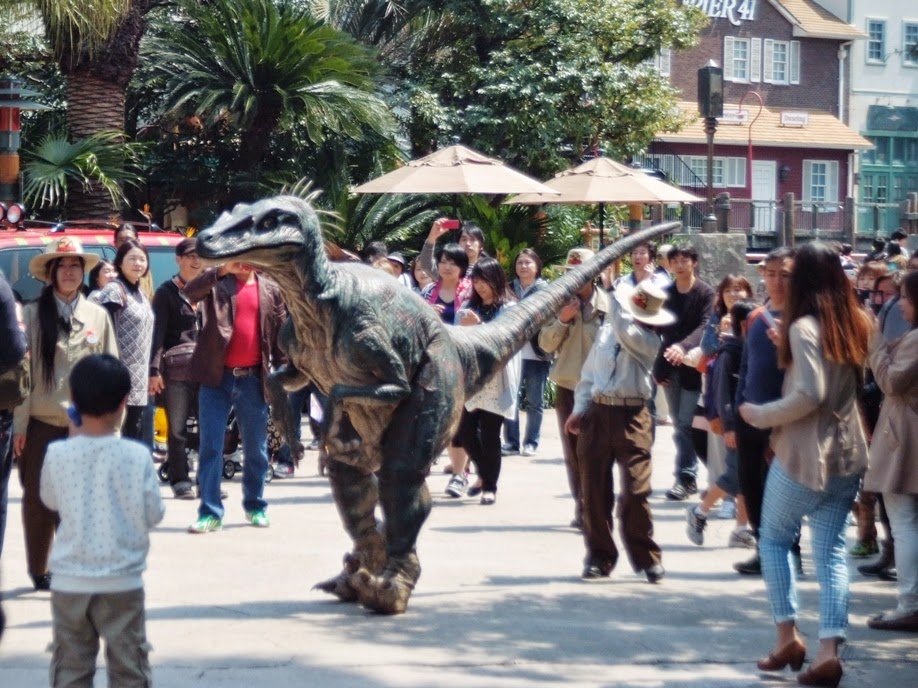 We really have to give credit to the Japanese when they design public amenities because every need is taken care of. The path to USJ is flanked by a row of shops and restaurants called Universal City Walk by Kintetsu (housing the takoyaki museum). To the left, a huge area is under construction, possibly another hotel of more shops. There are already 2 hotels outside USJ and the prices are steep.
We really have to give credit to the Japanese when they design public amenities because every need is taken care of. The path to USJ is flanked by a row of shops and restaurants called Universal City Walk by Kintetsu (housing the takoyaki museum). To the left, a huge area is under construction, possibly another hotel of more shops. There are already 2 hotels outside USJ and the prices are steep.The entrance showed the usual grandeur of universal studios and the music that welcomes you to the land of happiness, back to the future style. The obligatory Japanese lady smiles and bows at every visitor at the entrance with a Minnie mouse ears hair band, beginning your journey even before you reach the ticketing counter.
The ticket counter have signs in English and Japanese, and while they try to cater for tourists, I would say that in they still remain very Japanese. It's easy to buy tickets and signs are bilingual. The only difficulty one may face is trying to figure out whether the one-day ticket entitles a re-entry for a lunch break and restaurants outside the park, the answer is no, and these instructions were in Japanese.
 The park had changed a lot from my last visit 5 years ago. Notably, the number of F&B had been tremendously increased. The number of themed shops, though smaller, had also increased. These themed shops are at every attraction's entrance and exit, capitalising on the long queues for the bored customer's mind to want to take a look after their ride because they would have been sufficiently engaged by then - blankly staring at the flow of customers to the shop, feeling the ride was amazing, or simply having to just keep a memorabilia because of the anticipation built up during the X-hours long queue. Anyone interested in marketing or consumer behaviour would definitely pick up a few tricks.
The park had changed a lot from my last visit 5 years ago. Notably, the number of F&B had been tremendously increased. The number of themed shops, though smaller, had also increased. These themed shops are at every attraction's entrance and exit, capitalising on the long queues for the bored customer's mind to want to take a look after their ride because they would have been sufficiently engaged by then - blankly staring at the flow of customers to the shop, feeling the ride was amazing, or simply having to just keep a memorabilia because of the anticipation built up during the X-hours long queue. Anyone interested in marketing or consumer behaviour would definitely pick up a few tricks.With a toddler in tow proved a different sight seeing experience. She was scared of the screams from the roller coaster, a boat making a big splash from a 4-storey inclined descent, mascot dinosaur from the movie Jaws, and the sheer crowd.
 Her haven was actually a section of the park with a sesame street themed wonderland designed for children 7 and under - Elmo's Imagination Playland. Our introvert didn't like the crowd outdoors, so we gave the carousel and mini car ride (meant for children aged 3 to 5) a miss. She found her space in the indoor area where there were large spaces with individual play items to keep every little one occupied without feeling threatened, which was an enlightening design. These items were very simple - balloons, blocks, balls. Three types of objects, three areas of play.
Her haven was actually a section of the park with a sesame street themed wonderland designed for children 7 and under - Elmo's Imagination Playland. Our introvert didn't like the crowd outdoors, so we gave the carousel and mini car ride (meant for children aged 3 to 5) a miss. She found her space in the indoor area where there were large spaces with individual play items to keep every little one occupied without feeling threatened, which was an enlightening design. These items were very simple - balloons, blocks, balls. Three types of objects, three areas of play. The ball area attracted our girl a lot because they had a very interesting sink that takes in balls and spit them out through the shower head. It was cookie monster having a bath!
The ball area attracted our girl a lot because they had a very interesting sink that takes in balls and spit them out through the shower head. It was cookie monster having a bath!Unfortunately we didn't get to taste fantastic food because cafes and restaurants either had long queues or no queue. The cafe at the indoor area had no queue hence the food was understandable.
Overall it was not worth the money for us but it was an enlightening experience for me to learn more about how Japanese businesses design products or services to capture the market of the young parents and children. Eventually, when they grow up, they will return to these places they had good memories of. I would never have been able to experience and appreciate these designs had it not been for travelling with our girl, who was 3 years old when we ventured on this USJ excursion. I wouldn't go back again until she is older because of the high entry cost, but if I were a resident, I would buy an annual pass and visit it every week!














